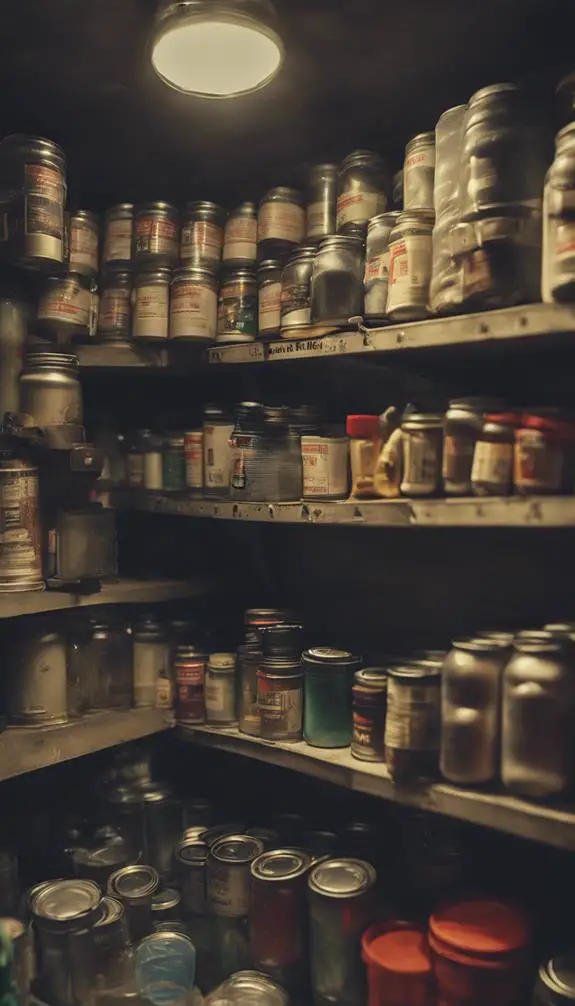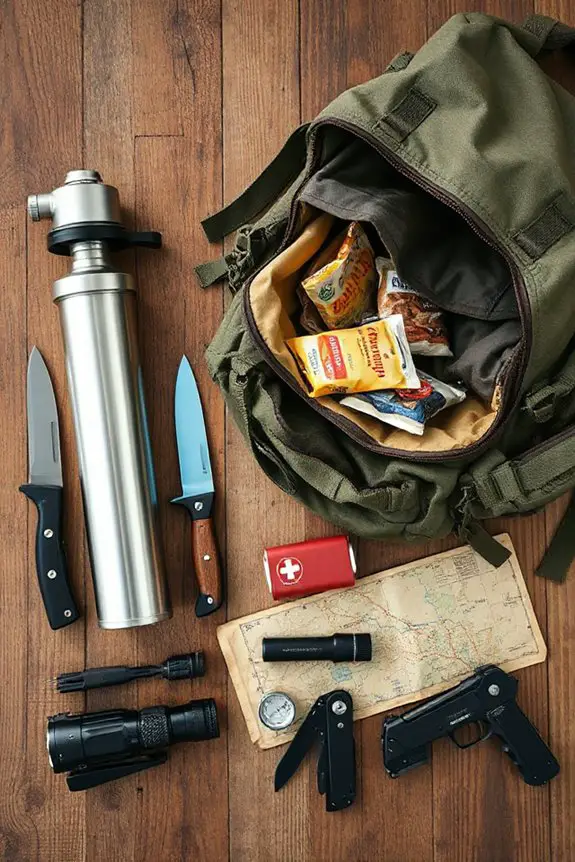You're not alone if you've ever wondered what you'd do in the face of a catastrophic event. As you're taking the first step towards preparing for the unknown, you're likely thinking, "Where do I even start?" From building an emergency fund to establishing a self-defense plan, the task can seem overwhelming. But, by breaking it down into manageable steps, you'll be better equipped to handle whatever comes your way. So, let's get started on this journey together – you'll soon discover that being prepared isn't just about fear, but about taking control of your future.
Summary
- Allocate 3-6 months' worth of living expenses into a readily accessible savings account for financial preparedness.
- Identify natural disaster threats in the area and develop a plan to mitigate their impact through risk assessment and planning.
- Stockpile non-perishable food items, invest in a food storage system, and learn food preservation techniques for sustenance.
- Create a safe haven with a solid protection strategy, including self-defense and security measures, and designate a safe room or bunker.
- Invest in a well-stocked Medical Kit, learn first aid skills, and prioritize sanitation and hygiene to avoid the spread of diseases.
Building an Emergency Fund
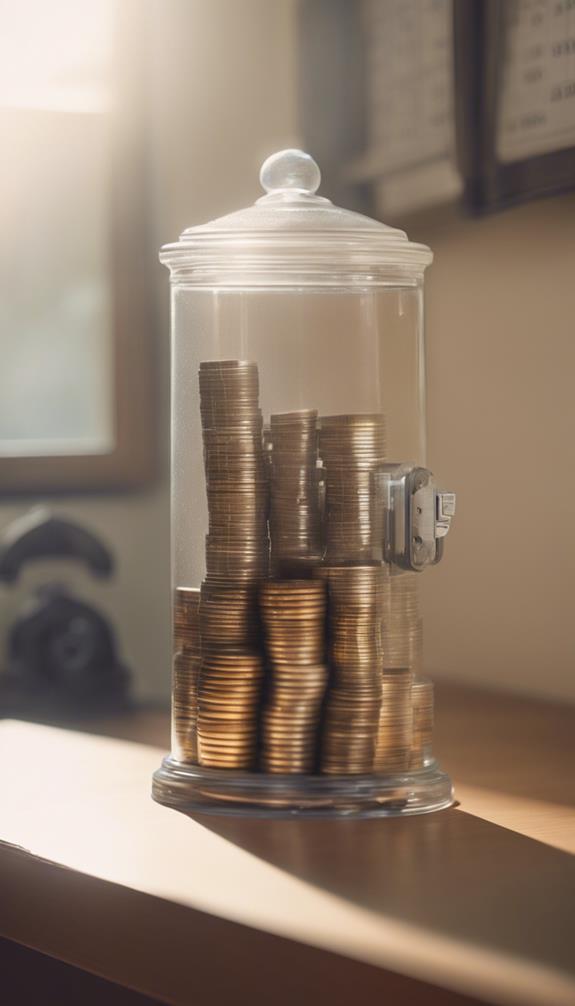
How much would you have set aside if a sudden job loss, medical emergency, or natural disaster were to strike tomorrow?
Building an emergency fund is vital for achieving financial freedom and peace of mind. Allocate three to six months' worth of living expenses into a readily accessible savings account.
Prioritize essential expenses like rent/mortgage, utilities, food, and minimum debt payments. Consider allocating 50-70% towards necessary expenses and 30-50% towards discretionary spending.
Review your budget to identify areas for cost-cutting and adjust your fund allocation accordingly. By doing so, you'll be better equipped to weather unexpected events and maintain your independence.
Assessing Your Risks

You need to identify the risks that are most likely to affect you, which means considering natural disaster threats in your area, such as earthquakes, hurricanes, or wildfires.
You should also assess your personal vulnerability factors, including your age, health, and financial situation, which can impact your ability to respond to emergencies.
Natural Disaster Threats
Living in a region prone to natural disasters can be a ticking time bomb, waiting to disrupt your life and threaten your survival.
You need to know the specific risks in your area. Are you near a fault line, where tectonic activity can trigger earthquakes? Or do you live in an area prone to hurricanes, wildfires, or floods?
Climate shift is altering weather patterns, making it essential to understand the potential threats. Research the history of natural disasters in your region and stay informed about weather forecasts and warnings.
Knowing your risks is the first step in preparing for the unexpected. By understanding the natural disaster threats in your area, you can develop a plan to mitigate their impact and guarantee your survival.
Personal Vulnerability Factors
Vulnerability lurks in the shadows of our daily lives, waiting to pounce when disaster strikes.
As you prepare for the unknown, crucially, you must acknowledge your personal vulnerability factors.
You must assess your risks and identify potential weaknesses that could hinder your survival.
Take an honest look at your mental health – do you struggle with anxiety or depression?
These conditions can impact your decision-making and coping skills during a crisis.
Next, consider your physical limitations.
Do you have a disability or chronic illness that may affect your mobility or ability to respond to an emergency?
Creating a Survival Plan
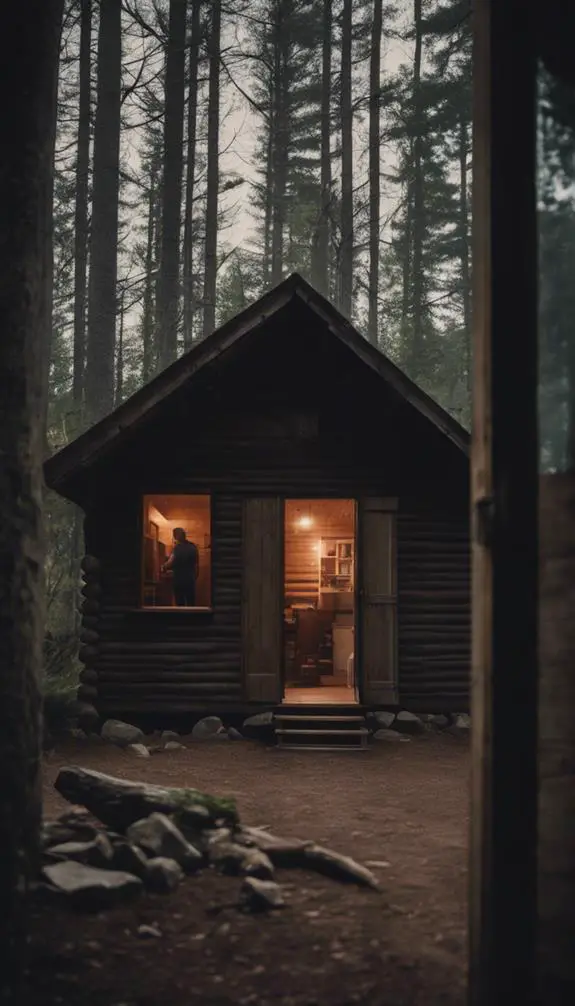
You've assessed your risks, now it's time to create a survival plan that'll help you stay safe when disaster strikes.
This plan should identify potential threats ahead, outlining strategies to mitigate or overcome them.
Identify Threats Ahead
Your survival plan begins with a thorough threat assessment.
You must identify potential catastrophic events that could disrupt your life and trigger global chaos.
Consider natural disasters like earthquakes, hurricanes, and wildfires, as well as man-made threats like cyber attacks, economic collapse, and pandemics.
Think about how these events could impact your daily life, from access to food and water to communication and transportation.
Be realistic about the likelihood and potential impact of each threat, and prioritize those that pose the greatest risk.
Plan for Emergencies
Now that you've identified potential threats, it's time to create a survival plan that addresses those risks.
This plan should outline your emergency response strategy, including evacuation routes, safe zones, and crisis response protocols.
Consider the unique needs of your household, such as pets, children, or elderly family members, and plan accordingly.
Develop a step-by-step guide for emergency planning, including communication protocols, first aid procedures, and shelter options.
Prioritize your plan based on the most likely threats and allocate resources accordingly.
Having a solid crisis response plan in place will give you peace of mind and increase your chances of survival in the face of disaster.
Establish Communication
Establishing reliable communication channels is crucial to survival in a crisis.
Without them, you'll be isolated and vulnerable. Invest in a two-way radio or a ham radio, and learn basic radio protocols to stay connected with family and allies.
Consider purchasing a satellite phone, which can operate even when traditional networks are down.
Designate a meeting point and a communication schedule in case you get separated.
Set up a messaging system using codes or ciphers to maintain secrecy.
Practice encrypting and decrypting messages to guarantee you're proficient in case of an emergency.
Stockpiling Essential Items
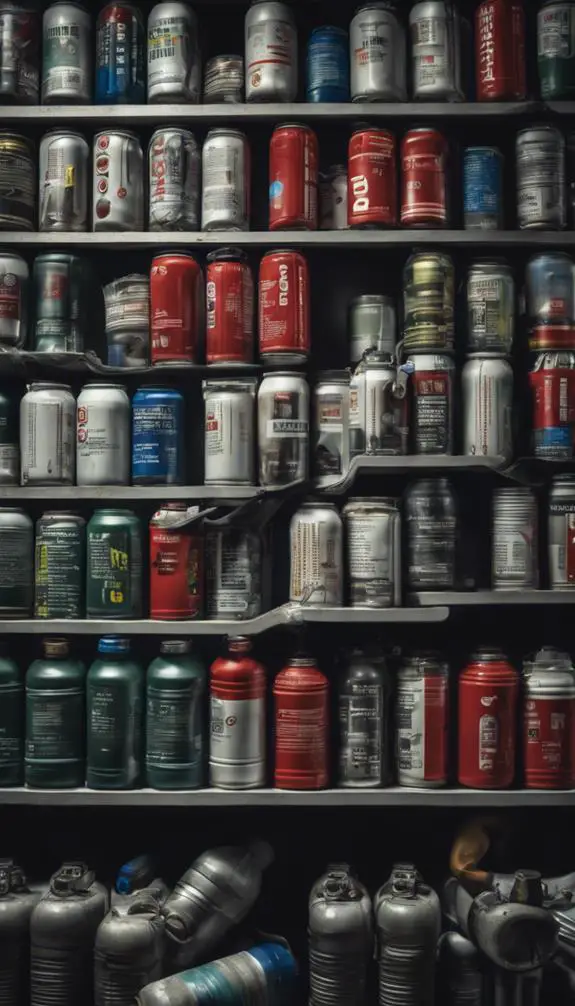
As the likelihood of a catastrophic event increases, it becomes crucial to assemble a cache of essential items that will help you survive and thrive in the aftermath.
You'll need to stockpile non-perishable food items that can be stored for extended periods. Focus on high-calorie, nutrient-dense foods like canned goods, dried fruits and nuts, and energy bars.
Consider investing in a food storage system that can keep your supplies fresh and organized. Don't rely on supply chains, which can be disrupted during emergencies.
Instead, build your own stockpile to guarantee you have a steady supply of food. Aim to store at least three months' worth of provisions to ride out any disruptions.
Water Storage and Purification
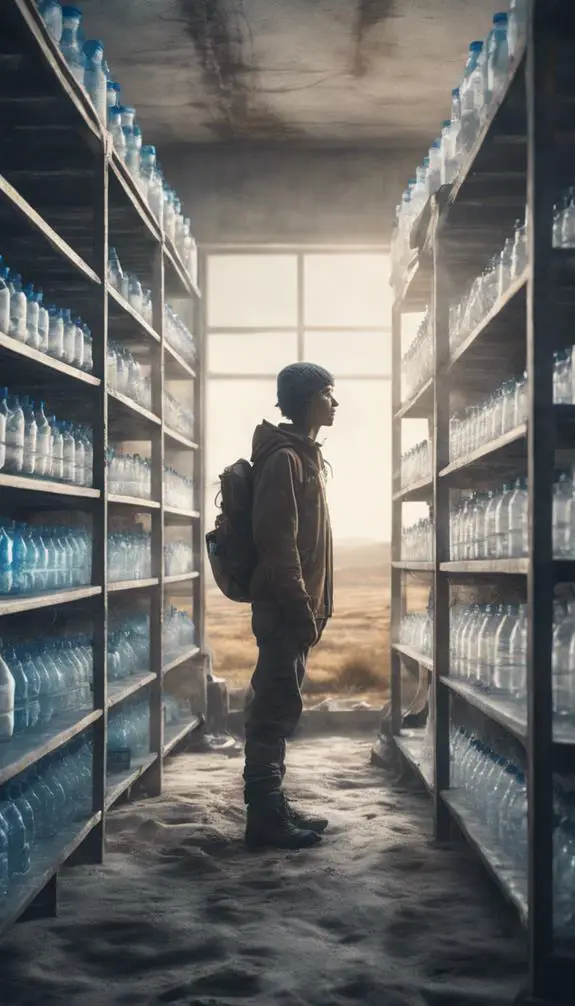
Having built a solid foundation of non-perishable food items, your next step is to secure a reliable source of clean drinking water.
Storing water is vital, but it's equally important to have a plan for purifying water in case your stored supply runs out.
Invest in durable Water Containers that can hold at least one gallon per person per day.
Consider adding Purification Tablets or a water filter to your kit to guarantee access to safe drinking water.
These tablets can eliminate bacteria, viruses, and other contaminants, making questionable water sources safe to drink.
With a solid water storage and purification plan in place, you'll be better equipped to handle any situation that comes your way.
Building a Sustainable Food Supply

You've stockpiled non-perishable food items and secured a reliable source of clean drinking water; now it's time to build a sustainable food supply that will keep you nourished for the long haul.
Start by learning food preservation techniques like canning, dehydrating, and fermenting to extend the shelf life of your harvest.
Invest in a garden or indoor growing system to cultivate your own fruits and vegetables. Implement crop rotation to guarantee soil fertility and minimize pests and diseases.
Consider raising livestock like chickens or rabbits for a steady supply of protein.
First Aid and Medical Preparedness
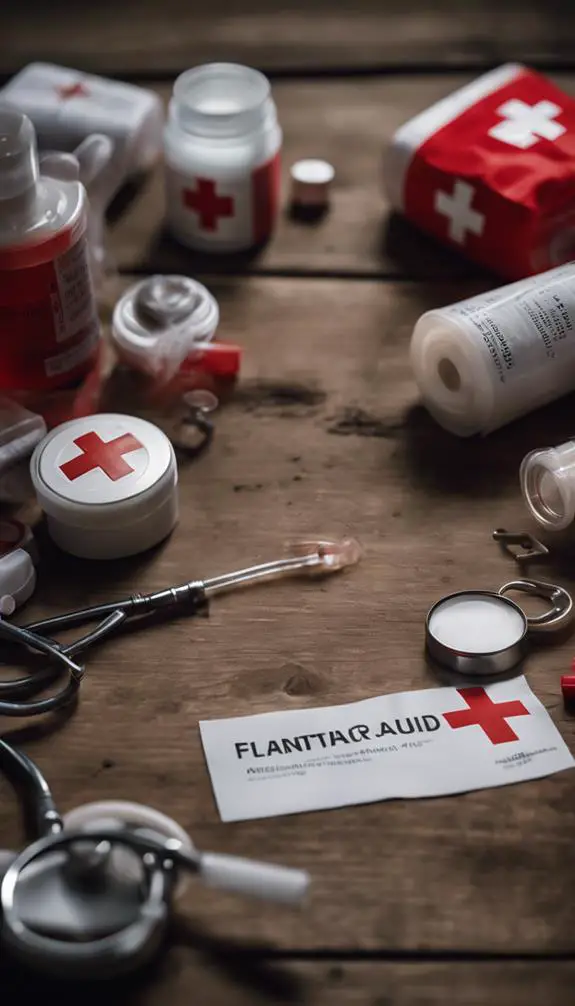
Get a handle on basic first aid skills to patch up minor injuries and prevent infections from getting out of hand.
You'll want to invest in a well-stocked Medical Kit that includes essentials like bandages, antiseptic wipes, and pain relievers. Knowing how to properly clean and dress wounds is vital, as is understanding Wound Closure techniques like suturing and stapling.
Practice these skills to boost your confidence in treating injuries. Additionally, consider taking a first aid course to learn more advanced techniques, such as splinting and CPR.
Shelter and Protection Strategies
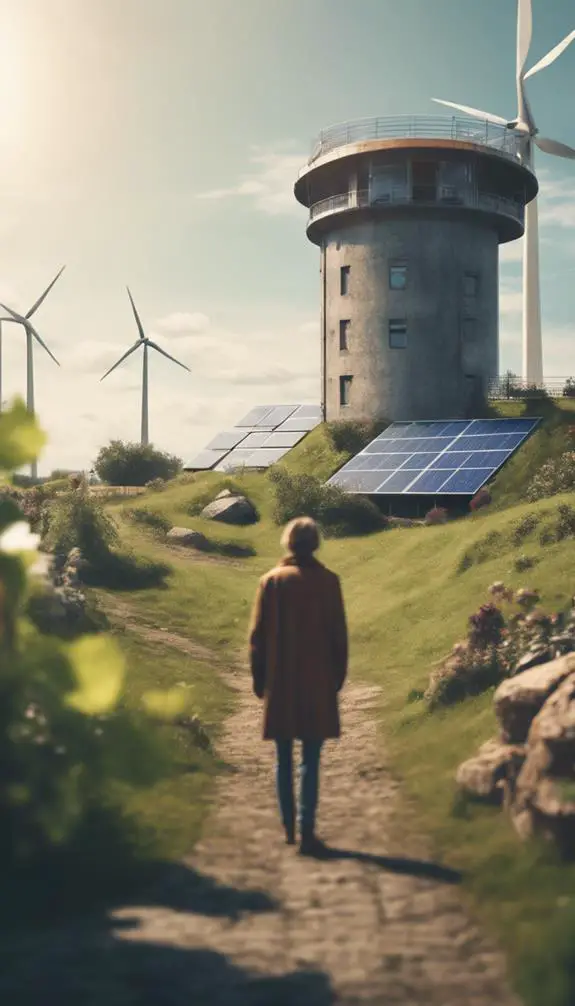
You're now moving on to one of the most critical aspects of doomsday prepping: shelter and protection strategies.
Your goal is to create a safe haven that can shield you from the outside world, and that starts with planning a safe room or identifying secure shelter options.
Safe Room Planning
Protection from chaos begins with a secure shelter, and a well-planned safe room is the cornerstone of any doomsday prepping strategy.
You'll want to designate a room in your home as a safe haven, where you and your family can retreat in case of an emergency. Consider a room with minimal windows and doors, and ideally located in the interior of your home.
When designing your safe room, think about incorporating hidden doors or secret compartments to conceal your supplies and protect your loved ones.
A well-designed safe room should also have a secure locking system, reinforced walls, and a reliable communication system.
Secure Shelter Options
Having a safe room in your home provides a strong foundation for your doomsday prepping strategy, but it's equally important to weigh secure shelter options beyond your home's walls.
Consider shelter upgrades, such as installing reinforced doors, security cameras, and motion-sensitive lighting. You may also want to explore bunker design, either by building one from scratch or converting an existing structure.
A well-designed bunker can provide a safe haven during catastrophic events. Research local building codes and regulations before starting your project.
Additionally, identify potential shelter locations, such as nearby woods or remote areas, in case you need to evacuate quickly. Having multiple shelter options will increase your chances of survival in the event of a disaster.
Communication and Navigation Tools
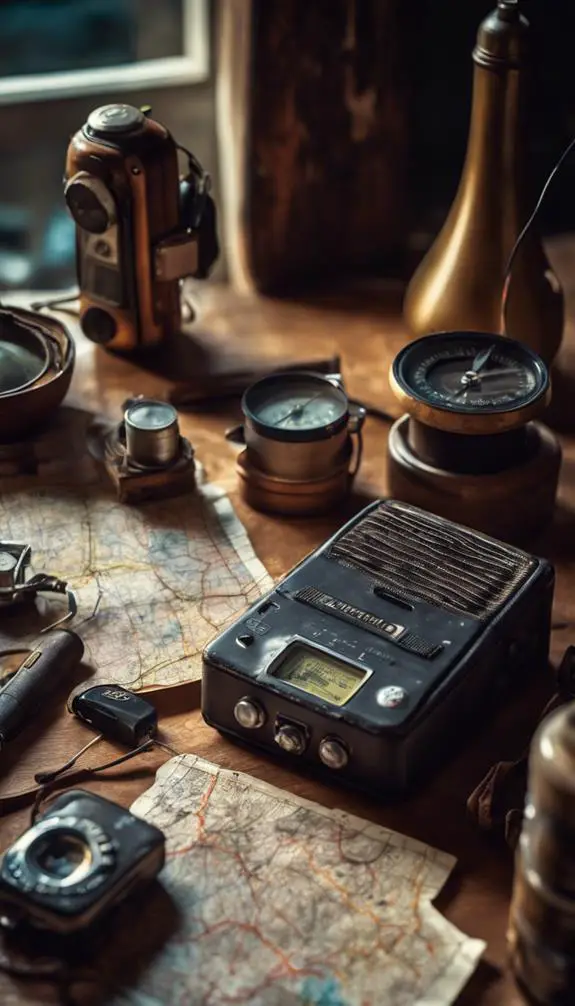
Staying connected and finding your way are crucial survival skills when disaster strikes, and the right communication and navigation tools can mean the difference between life and death.
You'll need reliable means to call for help, receive critical updates, and navigate through unfamiliar terrain.
Invest in a satellite phone, which can connect you to the outside world even when traditional networks are down.
A GPS device is also essential, providing you with accurate coordinates and directions.
Consider handheld GPS units or those built into rugged smartphones.
Don't forget to stock up on extra batteries, solar chargers, and waterproof cases to keep your devices functional in harsh environments.
With these tools, you'll be better equipped to survive and thrive in the face of disaster.
Alternative Energy Sources
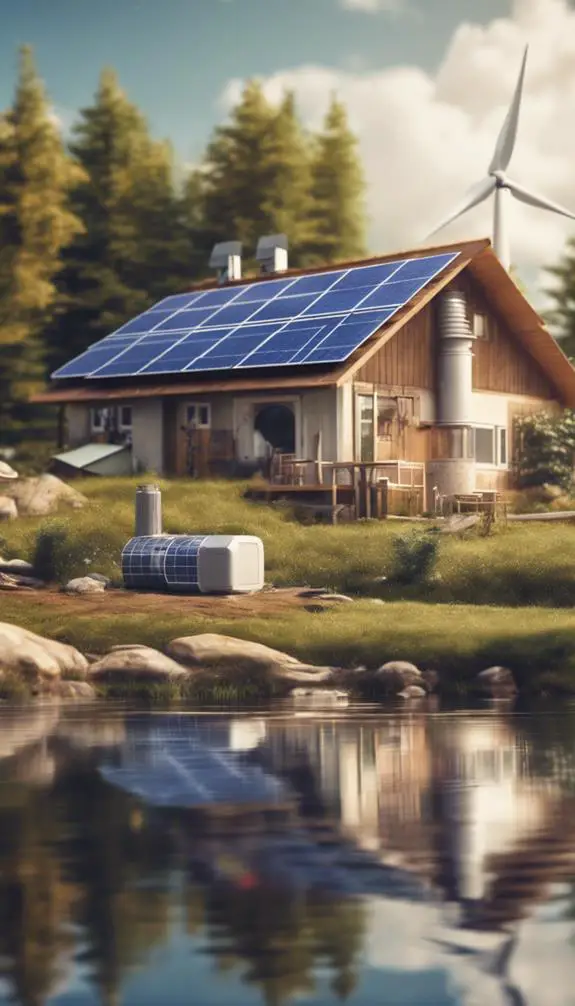
When disaster strikes, you'll need a plan to keep your devices powered up and your lights on.
Alternative energy sources are vital for off-grid survival. Solar panels are a reliable option, harnessing energy from the sun to charge your batteries. Install them on your roof or in a sunny area to generate electricity.
Wind turbines are another viable choice, converting wind energy into power. Consider a small, portable turbine for your doomsday prepping setup.
Both options are renewable, sustainable, and quiet, making them ideal for a post-disaster scenario. Invest in a battery bank to store excess energy for later use.
With alternative energy sources, you'll be self-sufficient and prepared to face the unknown.
Sanitation and Hygiene Essentials

At least 70% of diseases are waterborne, making access to clean water and proper sanitation crucial for survival in a post-disaster scenario.
You'll need a plan for waste disposal, toilet paper alternatives, and hand sanitizer options.
Consider stockpiling biodegradable soap, toilet paper, and hand sanitizer.
Don't forget toilet paper alternatives like baby wipes, cloth rags, or even leaves (if you're in a wilderness survival situation).
Hand sanitizer options include alcohol-based gels, baby wipes, or homemade solutions like vinegar and water.
You should also have a plan for disposing of human waste, such as digging latrines or using portable toilets.
Remember to prioritize sanitation and hygiene to avoid the spread of diseases in a post-disaster environment.
Self-Defense and Security Measures
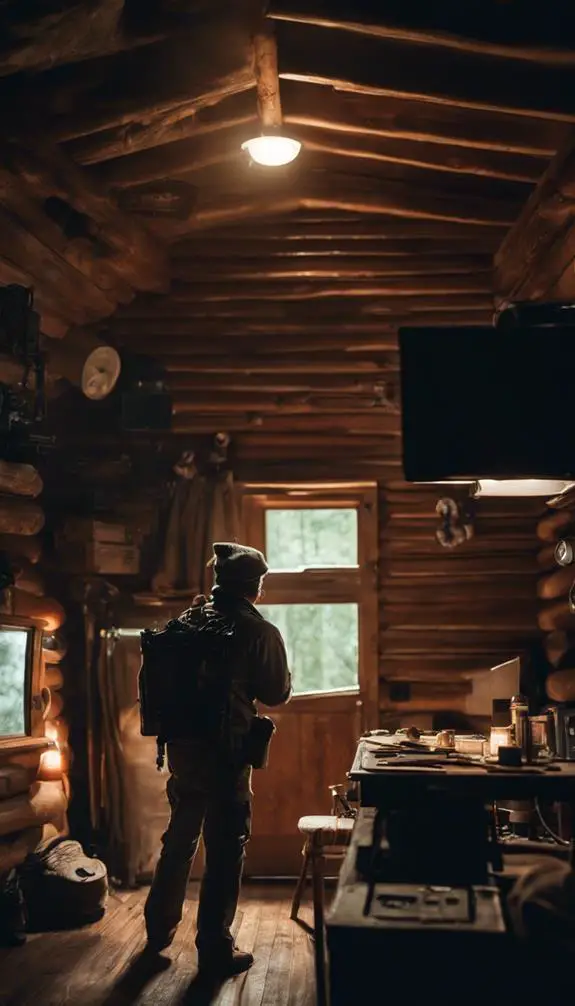
You face a formidable task in a post-disaster scenario: protecting yourself and your loved ones from potential threats.
Your home security is paramount, so prioritize securing your perimeter with sturdy doors, locks, and defensive barriers. Install motion-sensitive lights and consider investing in a home security system.
For personal safety, learn basic self-defense techniques and invest in non-lethal deterrents like pepper spray or a Taser.
Always stay alert and aware of your surroundings, trusting your instincts if you sense danger. A well-planned self-defense strategy will give you peace of mind and guarantee your family's safety in a crisis.
Staying Informed and Adapting

Frequently, the difference between survival and disaster lies in staying informed about the situation on the ground.
You must prioritize risk monitoring to stay ahead of potential threats. Establish a reliable information network to gather intel from trusted sources. This network can include ham radios, satellite phones, and online forums.
Stay tuned to local news and weather reports to anticipate changes in your environment.
You should also develop a system to verify the credibility of incoming information to avoid misinformation.
FAQs
Can I Prep for Doomsday on a Tight Budget?
You can prep for doomsday on a tight budget by embracing frugal shopping habits and seeking budget-friendly alternatives, like buying second-hand gear, DIY projects, and repurposing items, to guarantee your readiness without breaking the bank.
How Do I Balance Prepping With Daily Life Responsibilities?
You're juggling prep tasks with daily duties; master time management by scheduling prep sessions, and prioritize tasks using the Eisenhower Matrix to focus on high-impact activities, ensuring you're prepared without sacrificing daily responsibilities.
What if I Live in a Small Urban Apartment?
Living in a small urban apartment requires creative prepping strategies. You'll need to maximize urban storage by utilizing hidden spaces and vertical gardening to grow your own food, ensuring you're prepared without sacrificing precious space.
Can I Prep With Dietary Restrictions or Allergies?
You can definitely prep with dietary restrictions or allergies by identifying essential food substitutions and ensuring allergy-friendly storage solutions, like dedicated shelves or bins, to keep you safe and healthy in an emergency.
How Do I Involve My Children in Doomsday Prepping?
You involve your kids in doomsday prepping by explaining it from their perspective, making it a fun, family-bonding experience.
Conclusion
You've now taken the first vital steps towards ensuring your survival in the face of uncertainty. Remember, doomsday prepping is a continuous process that requires regular maintenance and adaptation. Stay vigilant, update your plan as needed, and always be prepared to pivot in response to new threats. By following these essential guidelines, you'll be well-equipped to face whatever the future may hold. Your preparedness is your best defense – use it wisely.

